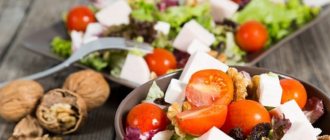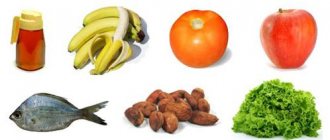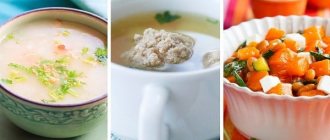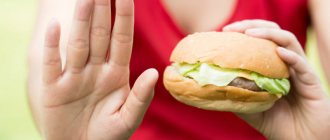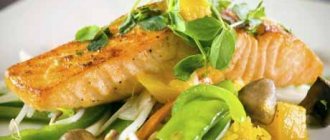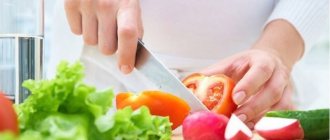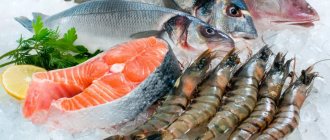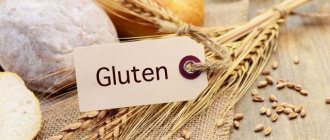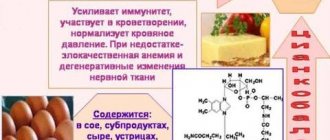Diet 11 indications for use:
1. Tuberculosis of the lungs, lymph nodes, bones, joints with a mild exacerbation or attenuation of the process or with reduced weight.
2. Exhaustion after infectious diseases, injuries, operations.
3.Anemia (with fat restriction).
The main condition for using diet 11 is the absence of damage to the digestive organs.
Purpose of prescribing diet 11: Diet No. 11 is prescribed to improve the body’s nutrition, increase the body’s defenses, and enhance recovery processes in the affected organ.
Characteristics of diet 11:
Diet No. 11 is complete, varied, with increased calorie content, with a predominantly increased amount of proteins, especially milk, mineral salts of potassium, iron and others, vitamins, an increase in carbohydrates and fats.
Chemical composition of diet No. 11:
Proteins – 110-130g (of which 60% are animal). Fats – 100-120g (of which 20-25% are vegetable). Carbohydrates – 400-450-550g. Free liquid – 1.5 l. Salt – 15g. Calorie content – 3000-3400-3800 kcal.
Culinary processing of products is varied. The food temperature is normal.
Diet: eat 5 times a day.
Features of the therapeutic diet 11 table ^
The eleventh therapeutic table diet is used in the following cases:
- Tuberculosis of the lymphatic system, lungs, joints and bone tissue;
- Exhaustion after undergoing serious operations, injuries and infectious diseases;
- Anemia, pneumonia.
Therapeutic and health-improving diet table No. 11 is aimed at improving nutrition, increasing the body's defenses and enhancing regenerative processes in diseased organs.
Advantages of diet-table 11
- Strengthening immunity;
- Increased hemoglobin levels;
- Replenishment of the deficiency of biologically active and nutrients and vitamins;
- Increasing the body's resistance to infections.
The nutritional principle of the therapeutic diet-table No. 11 is the increased consumption of protein and fortified foods. The amount of carbohydrates and fats in the diet also increases, but in moderation.
Calorie content and chemical composition
- The total calorie content of the dishes is 3400 kcal;
- 130 grams of proteins, of which 60% are animal;
- 450 grams of carbohydrates;
- 120 grams of fat, where 25% should be given to fats of vegetable origin;
- The volume of liquid for diet table 11 must be at least 1.5 liters;
- The amount of salt is 15 grams.
Culinary technology for preparing dishes of diet table No. 11 consists of stewing, boiling, baking and steaming.
What can you eat
Diet 11 table includes the following products in its food list:
- Pasta and cereals;
- Any dairy products;
- Low-fat types of meat dishes, seafood, fish, offal and poultry;
- Vegetables;
- Eggs;
- Berries, fruits - in any form;
- Any drinks;
- Rye, bran and wheat bread, cookies, biscuits, pies (baked), cheesecakes, etc.;
- Legumes;
- Natural jam and honey;
- Olive, vegetable and butter.
When compiling a therapeutic diet, increased attention should be paid to cheese, cottage cheese, buckwheat and oatmeal dishes. From the diet of diet table No. 11, it is necessary to completely exclude fatty, spicy and fried foods, lard, cooking oil, alcohol, carbonated sweet drinks, cakes and pastries.
A contraindication to the use of dietary methods is the presence of diseases of the digestive system.
Sample diet menu No. 11 (during the recovery period after acute pneumonia) for the day:
First option:
For the whole day: two hundred grams of wheat bread, Breakfast: one hundred and fifty grams of cottage cheese with the addition of ten grams of sour cream, twenty grams of sugar, a soft-boiled egg, a glass of sweet tea with lemon, 2nd breakfast: a plate of buckwheat with milk, Lunch: eighty grams of salad from vegetables with the addition of squid, half a portion of cabbage soup cooked in meat broth, 105 grams of beef stroganoff, two hundred grams of vegetable stew, sixty grams of grated carrots, a glass of tomato juice. Dinner: 150 grams of boiled fish, two hundred grams of fried potatoes, a glass of dried fruit compote.
This diet option is prescribed to patients with reduced immunity, general weakness, low-grade body temperature, and a sluggish course of the disease.
Main substances: one hundred grams of proteins, ninety grams of fats, three hundred and fifty grams of carbohydrates, daily calorie content of the diet - 2700 - 2800 kcal.
Meal mode: fractional, five meals a day.
Second option:
For the whole day: two hundred grams of wheat bread, Breakfast: one hundred and fifty grams of cutlets with carrots, twenty grams of sugar, one hundred and fifty grams of omelette with boiled meat, a glass of sweet tea with a slice of lemon, 2nd breakfast: a piece of cottage cheese casserole (two hundred grams), ten grams of sour cream, Lunch: eighty grams of vinaigrette, two hundred grams of borscht cooked in meat broth, one hundred and fifty grams of goulash, two hundred grams of mashed potatoes, a glass of tomato juice, sixty grams of apples baked with sugar, Dinner: one hundred and fifty grams of potato casserole with boiled meat, a glass of apple juice.
This diet option is prescribed to patients during an exacerbation of the process, if there is pronounced tissue breakdown, there is significant inflammation, which occurs with high fever and exhaustion.
Main substances: one hundred and twenty grams of proteins, one hundred grams of fat, four hundred grams of carbohydrates, daily calorie content of the diet - 3000 kcal.
If your appetite is reduced or your gastrointestinal tract is disrupted, this must be taken into account when planning your diet.
We eat pureed food.
Diet: fractional, every two to three hours.
Due to severe intoxication and decreased oxidative processes in the body, large amounts of ascorbic acid must be administered. Also, you need to consume 1200 milligrams of calcium per day, and you need to consume other vitamins.
You need to consume up to eight grams of salt per day.
Advice: you need to drink different drinks, fresh juices, vegetables, fruits containing many minerals and vitamins.
Third option:
For the whole day: two hundred grams of wheat bread, Breakfast: one soft-boiled egg, one hundred and fifty grams of curd pudding with the addition of dried apricots, a glass of coffee with milk, 2nd breakfast: one hundred grams of boiled meat pate, Lunch: eighty grams of vinaigrette, two hundred grams of noodles cooked in chicken broth, one hundred and fifty grams of goulash, two hundred grams of buckwheat, a glass of apple juice, sixty grams of fruit salad. Dinner: one hundred grams of mushrooms in sour cream, one hundred and fifty grams of potato casserole, a glass of dried fruit compote.
This diet option is used for exudative phenomena.
We eat unsalted food.
Main substances: one hundred grams of proteins, one hundred grams of fats, three hundred grams of carbohydrates, daily calorie content of the diet - 2700 kcal.
You need to consume at least 2000 milligrams of calcium.
Liquids should be consumed at least a liter.
Popular recipes for diet table No. 11 ^
The following recipes are perfect for diet table No. 11 according to Pevzner:
Berry-curd salad
- 100 gr. Soak oatmeal flakes in a glass of milk.
- Mix them with 300 gr. cottage cheese, 2 tbsp. sugar, 3 cups of wild strawberries, strawberries, lingonberries, raspberries, lemon juice and season with yogurt or cream.
Apple casserole
- Cook thick milk porridge from 100 gr. decoys. 120 gr. Grind sugar with 80 gr. butter and combine with semolina.
- Next, add the beaten whites of 3 eggs into the prepared mixture.
- Place half a portion of the mixture in a mold with butter and crackers, place 350 grams of thin slices on top. apples and cover with another layer of porridge and place in the oven.
Results and reviews from doctors ^
The results of using diet table No. 11 are simply wonderful:
- The healing process accelerates;
- The immune system is strengthened;
- Hemoglobin levels increase;
- Metabolic processes improve.
Thanks to the rich composition of the diet, diet table No. 11 is very easily tolerated. Its duration is determined by the attending physician individually, based on the patient’s condition.
Reviews of the 11 table diet show that its use has a positive effect on the weakened body of patients, accelerating their recovery and starting the process of restoring strength after suffering serious illnesses.
We also recommend watching an educational video with useful advice from specialist nutritionists about the three best fasting days that help you lose weight quickly and effectively:
happy-womens.com
Principle of nutrition on Diet Table number 11
A special feature of the diet table 11 is a balanced menu, which is calculated for the week. A varied diet for medical reasons helps to quickly recover from anemia, tuberculosis, and allows you to effectively lose excess weight.
According to the conditions of the diet table 11 M.I. Pevzner, the patient must consume a minimum of 3000-3500 kcal per day. The main principle of the therapeutic diet table 11 is frequent meals - at least 5-6 times a day. Preferences in the weekly menu are given to proteins and vitamins.
Recommended consumption:
- lean meat,
- chicken,
- fish,
- offal,
- all dairy products,
- cereals,
- pasta and bakery products,
- vegetables and fruits.
A therapeutic menu designed for a week will allow you to eat not only healthy, but also varied.
Of the restrictions on the diet menu for a week, table 11: high-calorie flour products, fatty meats, hot sauces and spices. Liquid consumption: water, tea, coffee, juices are not limited, but not less than 1.5 liters per day.
In the weekly menu for diet table 11, the consumption of alcoholic beverages is strictly prohibited!
When is it prescribed?
Diet table 11 is prescribed for low hemoglobin, overweight, as well as during the recovery period from tuberculosis and anemia. If you follow the diet table 11, a complex menu for the week is calculated. A diet rich in proteins and vitamins helps restore strength, strengthens the immune system, and normalizes functional processes in the body. A menu planned for every day of the week allows you to eat not only healthy and balanced, but also tasty.
During pregnancy
Doctors recommend that pregnant women follow the table 11 diet, which promotes the proper intrauterine development of the child and also increases the level of hemoglobin in the blood of the expectant mother. A correct, balanced menu for the week according to Pevzner, the predominance of nutrients and vitamins in the diet has a beneficial effect on improving resistance to various infections.
The main principle of nutrition during pregnancy while following the table 11 diet is frequent meals in small quantities. It is necessary that the menu for the week be as varied as possible.
High-calorie desserts: cakes and pastries are replaced with dried fruits and nuts in the treatment menu for a week. It is recommended to minimize the consumption of carbonated drinks in the diet, and completely avoid alcoholic beverages.
For weight loss
When dieting table 11 for weight loss, special attention when developing the menu for the week is paid to a full breakfast, which should include: cereals, dairy products, fruits or dried fruits, nuts. A set lunch will help you replenish your energy throughout the day. For dinner, lean fish with vegetables is suitable. In between main meals, snack on low-fat dairy products, boiled eggs or bread. For a week, you should avoid eating fatty, spicy, sweet and starchy foods. A well-designed menu for the week will allow you to lose weight without compromising your health.
General principles of nutrition
Basic principles of therapeutic nutrition:
- Daily calorie content is 3600 units. During an exacerbation of the disease and subject to bed rest, the norm is reduced to 2700 kcal.
- Nutrition for pulmonary tuberculosis involves including fermented milk products, vegetables, fruits and juices in the menu to restore the balance of vitamins and minerals. Patients require magnesium, potassium, iron and calcium.
- It is recommended to reduce salt intake to 15 g per day. For patients with severe tuberculosis, this figure is reduced to a minimum.
- Proper nutrition involves including fish oil in the diet, as it promotes faster recovery.
- You should eat 5 times a day at intervals of 3 hours. Portions should be small in volume.
- The amount of water consumed per day should not exceed 2 liters. Patients with kidney problems are advised to drink no more than 1 liter of liquid.
- You should not eat cold or hot food. Food should be warm or brought to room temperature so as not to irritate the gastrointestinal system.
- Recommended cooking methods: boiling, stewing, baking, frying (with a little oil).
- A diet for tuberculosis in children involves a balanced and healthy diet. Calorie intake depending on age:
- 4-6 years – 2000 kcal;
- 8-12 years – 3000 kcal;
- 14-17 years old – 4000 kcal.
Diet therapy in the treatment of tuberculosis is important, because the speed of the patient’s recovery depends on a properly designed menu.
Squirrels
The effect of protein on the body:
- scarring of the lesion;
- increasing protective properties;
- providing the body with nutrients such as vitamin B.
Nutritional habits depend on the degree of the disease. The daily protein intake is 130 g, with anemia this amount increases to 140 g. In patients with acute development of the disease, proteins should not occupy a large part of the menu.
In the chronic stage, it is recommended to double the daily protein intake.
During illness, proteins break down faster, so it must be constantly present in the body. Preference should be given to dairy products, as they are best absorbed. A large amount of protein is found in lean fish, veal, eggs and chicken.
Fats
Therapeutic nutrition for tuberculosis involves reducing the proportion of fats in the diet. These substances complicate the digestion process, which negatively affects the functioning of the liver. The daily norm is 100 g. In case of anemia, this figure decreases to 80 g, since fats interfere with the absorption of iron.
Preference should be given to milk fat, since it does not cause obesity and is better absorbed. Recommended Products:
- sour cream;
- butter;
- cream;
- olive oil;
- sunflower oil.
Carbohydrates
The disease negatively affects the pancreas, so it is recommended to support it with carbohydrates. The daily intake is 450 g. Larger amounts of this substance can lead to obesity. Honey, sugar and jam should make up 1/5 of the total carbohydrates. Easily digestible substances (bread, flour products, semolina and rice) should be consumed in smaller quantities. Preference is given to fruits, vegetables, buckwheat and oatmeal.
Vitamins
To prevent tuberculosis and during its treatment, you should supply the body with the necessary vitamins and minerals:
- Calcium. Contained in dairy and fermented milk products, nuts, dried apricots and sesame.
- Vitamin A. Egg yolk, tomatoes, bell pepper, fish, carrots.
- B vitamins. Bran bread, liver, yeast, durum wheat pasta.
Special vitamin complexes will help replenish the body's need for nutrients. Recommendation for patients whose disease is in the decay stage: the daily intake of vitamin C should reach 300-400 mg.
Important information: Does the use of badger fat help with pulmonary tuberculosis?
Contraindications
Diet table 11 has virtually no contraindications. An exception is diseases of the gastrointestinal tract, in which the patient is prescribed a strict diet that does not allow deviations from the menu prescribed by the doctor.
The main value of the Table 11 diet is the overall strengthening of the body, especially during the recovery period after illnesses such as tuberculosis and anemia. Diet table 11 is indicated during pregnancy, as well as when losing weight. After literally a short period of time, adhering to the prepared menu for the week, the patient begins to feel a surge of strength and vigor, especially when exhausted. By adhering to the prepared menu, after a week the patient’s body is enriched with beneficial vitamins and minerals, immunity increases, hemoglobin levels increase and resistance to various infections increases.
diet-diet.ru
Characteristics of therapeutic diet No. 11
Diet No. 11 has an increased calorie content with a predominant increase in proteins, calcium salts, iron and vitamins (especially group C). With a moderate increase in carbohydrates and fats. Culinary food processing is ordinary. Following this therapeutic diet, you need to eat five times a day.
The daily ration of diet No. 11 includes 120 grams of proteins (of which 60% should be animal), 400-450 grams of carbohydrates, 100-120 grams of fats (of which 20-25% should be vegetable), 12-15 grams of salt, 1. 2-1.5 liters of free liquid. The calorie content of diet No. 11 is 3300 kilocalories per day.
Diet No. 11 allows you to consume:
Bread and flour products
Rye and wheat bread of the 1st and 2nd grade, any flour products (cookies, muffins, pies, biscuits, etc.).
Meat and fish
Lean types of meat, fish and poultry, cooked in any culinary preparation (fried, boiled, stewed, steamed). Sausage, sausages, bacon, ham, any (sea, river) low-fat fish, caviar, canned food (sardines, sprats, etc.), seafood.
Soups
Diet No. 11 allows you to consume any not very fatty soups.
Dairy
Any low-fat dairy products with the obligatory inclusion of cheese and cottage cheese.
Eggs
Chicken and quail eggs fried, boiled and steamed.
Vegetables, fruits and berries
Any vegetables, fruits and berries, prepared in any culinary way, including raw.
Cereals
Various cereals (rice, buckwheat, oatmeal, millet, semolina, etc.), pasta. Well-cooked legumes (beans, peas) in the form of puree.
Snacks, spices and sweets
Various snacks (especially fresh vegetable and leafy salads) and spices (in moderation). In moderation, Diet No. 11 allows you to consume any (except forbidden) sweet foods and dishes (honey, jam, etc.).
Sauces
Low-fat meat, dairy, sour cream and milk-egg sauces.
Fats
Natural vegetable oils, butter, and ghee can be used for preparing various dishes.
Beverages
Any drinks (except alcohol and sparkling water). It is imperative to drink natural vegetable, berry and fruit juices, as well as rosehip decoction.
Diet No. 11 (Table No. 11) - food
What can you eat on diet number 11:
Soups: any soups you like are allowed.
Cereals: any different cereals, especially buckwheat and oatmeal, pasta, also whole grains (boiled or pureed).
Vegetables, herbs: different, in any form, but most often raw.
Meat, fish: different types of meat, poultry and fish, excluding only very fatty ones, in any cooking method. Also allowed: liver, ham, sausage, frankfurters, herring, caviar, balyki, canned fish, etc.
Eggs: in any quantity, in different types of preparation.
Fruits and berries: consumed in large quantities fresh, as well as in various culinary preparations.
Dairy products: the entire range is allowed, cottage cheese and cheese are required.
Sweets: honey, jam, jam and any other sweet dishes.
Flour products: wheat and rye bread, all kinds of flour products.
Fats: vegetable oil and butter in their natural form, ghee - for cooking.
Drinks: any variety of drinks, always fruit and vegetable juices, as well as a decoction of rose hips and bran.
What not to eat on diet number 11:
- very fatty meats, poultry and fish;
- beef, pork, lamb and cooking fats;
- fatty and spicy sauces;
- pastries and cakes with a huge amount of cream.
Sample diet menu No. 11
Breakfast: salad made from fresh white cabbage and green apples with the addition of sour cream, oatmeal cooked in milk, an omelette made from two chicken eggs, green or black tea with milk. Second breakfast: 2-3 slices of mild cheese, one cup of tea. Lunch: borscht cooked in meat broth with low-fat sour cream, fried chicken with boiled white rice, one glass of fruit compote. Afternoon snack: rosehip decoction or a glass of natural juice. Dinner: meat zrazy stuffed with eggs and onions, casserole made from buckwheat with low-fat cottage cheese, carrot puree, one cup of tea.
Drink one glass of low-fat kefir 15-20 minutes before bed.
Diet No. 11, table No. 11 belongs to the categories - therapeutic diets.
| < Kefir diet for infectious diseases | Diet for hepatitis > |
all-diety.ru
Diet number 11 is prescribed for the following diseases and conditions:
- tuberculosis of the lungs, lymph nodes, bones, joints - in the stage of mild exacerbation or attenuation of the process, in the absence of concomitant diseases of the internal organs;
- Low body weight after surgery or infections.
The purpose of table No. 11 is to increase the body’s resistance (defenses), strengthen overall nutrition, restore vitamin balance, and enhance recovery processes in the affected organ.
Diet number 11 is characterized by an increased calorie content, an increase in the content of proteins, vitamins, and microelements in the diet, and a moderate increase in carbohydrates and fats.
Composition of diet No. 11:
- fats - 100-120 grams;
- proteins - 120-140 grams;
- carbohydrates - 500-550 grams.
Energy value - 3500-4000 kcal.
- Meat and poultry: varieties with very high fat content.
- Fats: beef, lamb, cooking.
- Confectionery products with a large amount of rich cream.
- Wheat and rye bread, pastries.
- Soups: a wide variety, in any broth.
- Fish, meat and poultry: any varieties except very fatty ones. Offal, sausages, ham. Fish and seafood.
- Dairy products: all without exception. Be sure to consume cottage cheese and cheeses.
- Eggs: in any culinary preparation.
- Dishes from any cereals, pasta. Legumes, well boiled - in the form of puree.
- Fruits, berries, vegetables - in full assortment with no contraindications, in any culinary processing. Be sure to consume some of it raw.
- Various salads, appetizers, sauces, herbs.
- Vegetable oils, butter and ghee.
- Confectionery, sweet dishes, preserves, jams, honey.
- Any drinks. Vegetable, fruit and berry juices and rosehip decoction are required.
Enhanced nutrition table - diet number 11 involves eating 5 times a day. Culinary processing of food should be varied; there are no restrictions in the absence of concomitant diseases.
www.medsectre.ru
Indications for prescribing diet 11
Diet 11 is a diet for weight gain, which is prescribed to people with tuberculosis of the lungs, bones, joints, lymph nodes, which occurs in the stage of attenuation or mild exacerbation, accompanied by a decrease in body weight, as well as pneumonia, anemia, leukemia.
Also, a diet for weight gain is prescribed for exhaustion caused by past infectious diseases, injuries, surgeries, as well as poor nutrition. There are several varieties of diet 11, which are prescribed to the patient depending on the nature and location of the disease, the condition of the internal and digestive organs, and the presence of any complications.
The goal of diet 11 is to improve the nutrition of the body as a whole , increase its overall resistance, strengthen the protective functions of the body, as well as enhance recovery processes in affected or damaged organs.
The essence of the diet
The main task of treatment table No. 11 is to saturate a person with nutritional components and give him the energy he needs throughout the entire treatment period. The diet contains the basics for simulating the body’s immune defense, improving resistance to infectious diseases, activating the resumption of processes in damaged organs, and restoring their productive functioning.
Therapeutic diet, table 11, has a high calorie content, contains a large amount of animal proteins, easily digestible carbohydrates, and fats. The affected organ tissues, the process of the formation of blood cells, and the improvement in the quality of immunity depend on the amount of microelements, minerals and vitamins received, which are fully provided by the diet.
We must not forget that the body is still weak and table number 11 has a gentle effect, because The digestive system is depressed and is not ready to cope with serious stress. Table 11 maintains the required level of hemoglobin and protects the walls of blood vessels. Food fibers perfectly cleanse the intestines, where toxins and chemicals from medications have accumulated due to long-term illness.
To improve appetite, the therapeutic diet contains dishes with extremely pleasant taste characteristics. Despite the fact that table 11 includes a variety of boiled, stewed, baked and steamed dishes, their appearance is given great importance. Based on the type of recipe, the degree of prepared food ranges from 15 to 65.
Chemical composition of the diet
The menu that the therapeutic diet offers is high in calories and contains a complete diet that promotes a quick return of the body to normal performance.
A healthy person needs 1500-2000 kcal per day; diet table 11 has 3000-3500 kcal.
The daily diet of chemical components that diet table 11 offers includes:
- 120 gr. proteins, animal origin of which is not less than 60%;
- 100-110 gr. fats, about 50% vegetable;
- 350-500 gr. easily digestible carbohydrates.
The daily menu, as dictated by the diet, may contain no more than 15 grams of table salt (about 7 grams for tuberculosis).
The recommended volume of fluid is one and a half to two liters per day.
With different types of illnesses, the menu also changes. If the disease is accompanied by diabetes, the diet undergoes changes, reducing the amount of absorbed carbohydrates, adding the amount of vegetable fats and proteins. In case of anemia with iron deficiency, reduce the volume of fat absorption to 80-90 g, adding proteins to 140 g.
Composition and calorie content of the diet
Due to the characteristics of the disease associated with weight loss, the diet has a higher caloric content compared to normal nutrition and is about 3000-3500 kcal per day. Basically, this amount of calories is achieved by increasing protein foods of animal origin. The amount of fats and carbohydrates increases slightly. Additional minerals and vitamins are also introduced into the diet, especially the daily calcium intake is increased.
There are no special requirements for heat treatment of food. The consumption of free liquid, as with proper nutrition, is 1.5 liters. You need to eat at least 5 times a day.
What is possible, what is not
Recommended:
- Products made from wheat or rye flour; dried fruits, nuts, and seeds can serve as additives;
- Butter rolls, pies, pies, cookies, etc.;
- Eating absolutely any soups with richness, be it broth from mushrooms, fish or meat;
- The diet includes seasoning soups, the basis for which is semolina, flour, and the addition is cream or sour cream;
- The table contains milk soups;
- Pig, lamb, and cow meat are popular on table 11;
- Table 11 includes turkey, duck, goose, chicken and rabbit meat;
- Prepared using breading and grains;
- Various sauces for meat dishes are recommended;
- It is beneficial to eat semi-fat or fatty fish. The diet allows you to eat canned fish, balyk, cod liver, and caviar. To improve your appetite, it’s a good idea to include herring in your diet;
- There are no restrictions on high-fat dairy products: for cheese it is 45-60%, cottage cheese 9-18%, sour cream and cream 25%, milk 3.6-6%. The effect of consuming fermented milk products is expressed in improving the microflora of the intestinal tract;
- You can eat no more than 2 eggs per day, any preparation, but preference is given to an omelet filled with cheese, meat or herbs;
- Pasta and various cereals;
- Diet table number 11 contains vegetables that have a high glycemic index. They prepare dishes with both raw vegetables and fried, boiled, baked, crumbled into stews and salads.
It is very important to pay special attention to the decoration of dishes, because they should immediately create an appetite. Beautiful decoration and table setting will also help in this matter.
- Sweets, fruits that have a sweet and sour taste, can be used for filling pies, pies, as well as compotes, jams and other things. Honey, jam and refined sugar are allowed;
- Attention is paid to snacks, because... the task is to improve and increase appetite. These are salads, slices or seafood;
- All drinks are suitable, including decoctions of herbs and plants, varieties of compotes, tea and coffee.
Not recommended:
- Fatty meats;
- Cakes, pastries with rich cream;
- Hot sauces, seasonings;
- Cooking, beef and lamb fats are prohibited.
Diet No. 11 (table No. 11): menu for the week
Diet No. 11 is varied and beneficial for the body. Below is a sample menu for table No. 11 for the week.
Prepare food in any way you like. Serving temperature 15-65°C. In addition to eating, don't forget to drink water.
Monday
Breakfast: omelet, cottage cheese with fruit and sour cream, a bun with tea. Lunch: cheese, rose hip decoction. Lunch: chicken noodle soup, vegetable stew, tea. Afternoon snack: fruit. Dinner: potato zrazy with meat or cabbage, vegetable salad, compote.
Tuesday
Breakfast: cheesecakes with sour cream and jam, coffee with milk. Lunch: fruit jelly. Lunch: borscht with sour cream, pampushki with garlic and herbs, bran decoction. Afternoon snack: fermented baked milk, cookies. Dinner: lazy cabbage rolls, vegetables.
Wednesday
Breakfast: omelet with sausage, onion and tomato, carrot and apple juice. Lunch: fruit jelly. Lunch: cream soup with mushrooms, chicken fillet, vegetable salad. Afternoon snack: yogurt with cereals. Dinner: mashed potatoes, goulash, baked vegetables.
Thursday
Breakfast: sweet milk soup with oatmeal, cheese sandwich, tea. Lunch: fruit. Lunch: soup with meatballs and rice, stewed cabbage with meat, juice. Afternoon snack: cheese, tea. Dinner: pasta, chicken cutlets, vegetable salad, jelly.
Friday
Breakfast: sweet rice with apples, juice. Lunch: milkshake with fruit. Lunch: chicken soup with barley, steak, vegetables. Afternoon snack: fruit. Dinner: pilaf, fresh cabbage salad with carrots, tomato juice.
Saturday
Breakfast: pancakes with cottage cheese and sour cream, coffee with milk. Lunch: fruit salad. Lunch: chicken soup with cauliflower, vegetable stew with meat. Afternoon snack: juice. Dinner: boiled potatoes, baked fish with vegetables, compote.
Sunday
Breakfast: sweet oatmeal with fruit and cream, cocoa. Lunch: sandwich, tea. Lunch: borscht with sour cream, pancakes with meat, compote. Afternoon snack: berries, fruit, juice. Dinner: buckwheat, cutlets, vinaigrette.
Menu for every day
When choosing products for the menu, you need to ensure that their benefits are maximum and contain a large amount of all the necessary components in a small volume. The list of dishes is compiled for the week.
With proper adherence to the diet, food is divided into 5-6 meals, including breakfast, lunch and dinner.
Monday:
- Semolina porridge with jam, cheesecake, apricot decoction;
- Cocoa with cookies;
- Lagman, pea soup with meat, orange juice;
- Any type of fresh berries;
- Yogurt, wheat milk porridge, cheesecakes with jam.
Tuesday:
- Rice pudding, fresh vegetable salad, seasoned with sour cream, kefir;
- Sea kale salad;
- Chicken soup, cabbage stew, cranberry juice;
- Fruits;
- Cake with milk, boiled beans.
Wednesday:
- Stewed rice with vegetables, egg and cocoa with milk;
- Cottage cheese and fruits;
- Meat soup, mashed potatoes with sausages, pomegranate juice;
- Pudding;
- Zucchini caviar, “Herring under a fur coat” salad, bread and tea.
Thursday:
- Corn grits porridge, hard cheese, apple and carrot juice;
- Apricot puree, cherry compote;
- Rice with duck, tomato soup, coffee with cream;
- Salad of hard cheese, carrots and apples;
- Pea porridge, beef cutlets, milk.
Friday:
- Buckwheat, vinaigrette, drink to taste;
- Manna with fruits;
- Soup with smoked meats, stewed chicken, decoction of rose hips and strawberries;
- Fruits;
- Fat cottage cheese with apple, cucumber and cabbage salad, chamomile tea with lemon.
Saturday:
- Oatmeal with fruits, apple compote;
- Kefir and apple pancakes;
- Pilaf, solyanka with breadcrumbs, tea;
- Fruit salad with full-fat yogurt;
- Vegetable salad, spaghetti with cheese, cocoa.
Sunday:
- Cabbage salad, sausage omelette, orange juice;
- Sesame cookies, any tea, milk;
- Cabbage soup, kurnik, lingonberry broth;
- Cottage cheese, carrot-pumpkin juice;
- Buckwheat cutlets, pumpkin pudding, milk.
Diet menu option 11 for a patient with pulmonary tuberculosis with significantly reduced immunity
Breakfast: oatmeal porridge with butter, milk, tea.
Second breakfast: omelet with boiled meat and dried apricot mousse.
Lunch: cabbage soup in meat broth with sour cream, goulash with vegetables, grated carrots, fresh apple compote.
Afternoon snack: apricot juice.
Dinner: meatballs cooked in tomato sauce, cabbage casserole, beetroot puree, tea with lemon.
Before bed: milk.
Additionally for the whole day - 200 g of wheat and 200 g of rye bread, 20 g of sugar.

